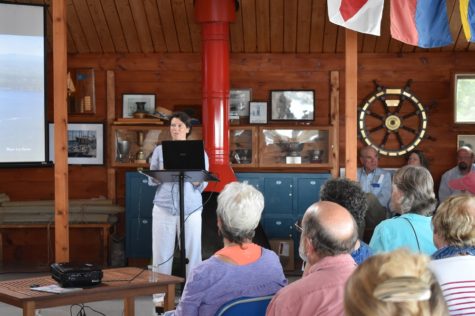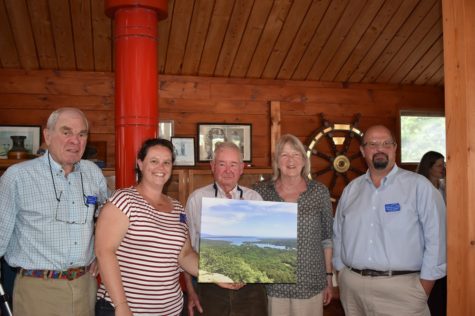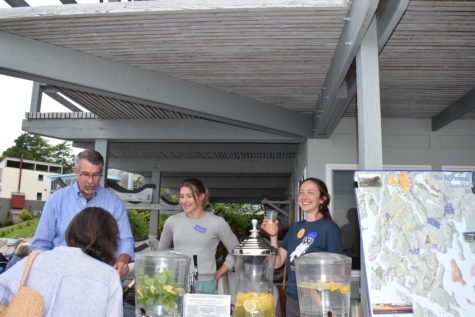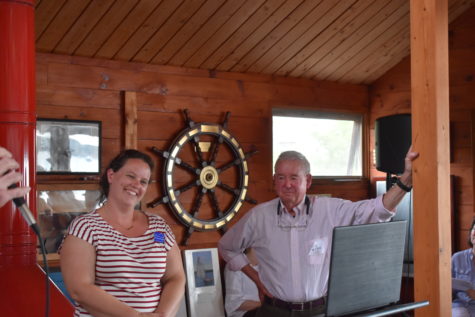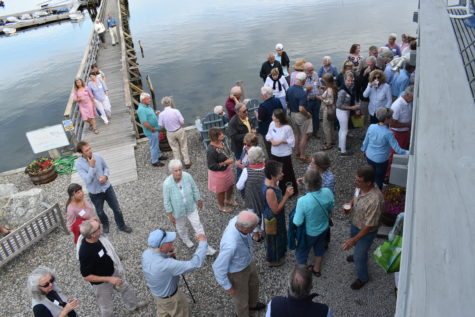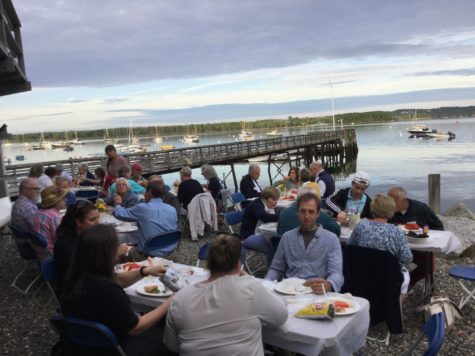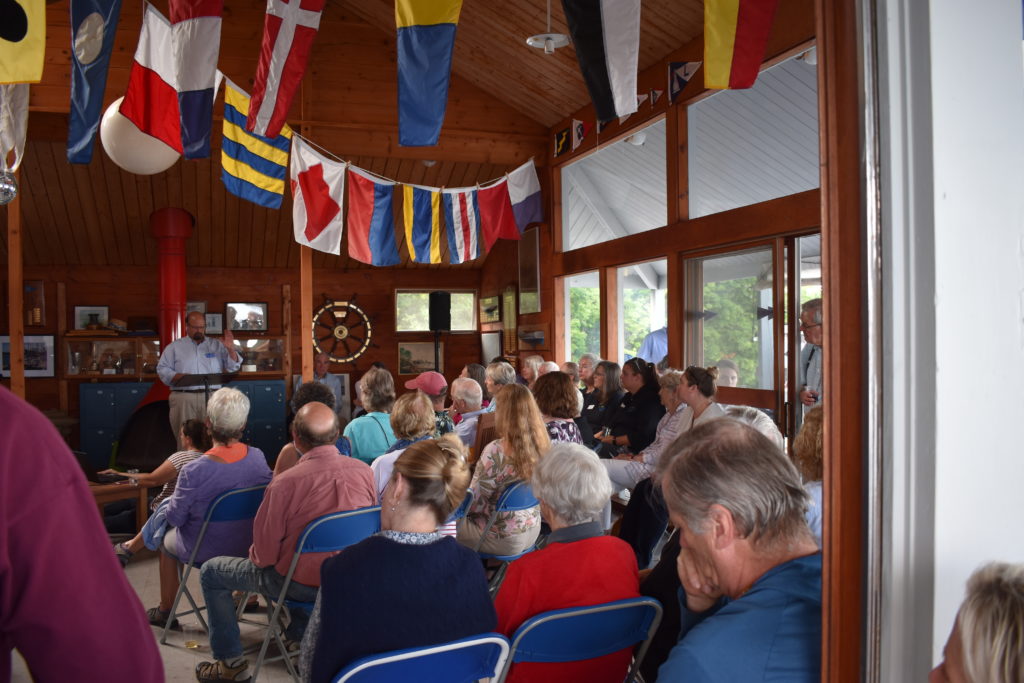
In July we held our annual meeting in Castine on their beautiful harbor. We chose to take this event to Castine this year in celebration and recognition of the 5th anniversary of the merger of The Conservation Trust of Brooksville, Castine and Penobscot with BHHT back in 2014. It was wonderful to have former Board Members, Volunteers and Supporters of TCT with us that evening as we celebrated all we have accomplished together over the past 5 years.
We also reflected on community and what it means to do Community Conservation. Zoe Tenney from Northern Light Blue Hill Hospital was our guest speaker and talked about the important role land trusts play in community health.
We ended the event with a fabulous lobster bake (a TCT tradition) and enjoyed breaking bread together!
Below please enjoy a few photos from the event, as well as the talking points from our speakers that evening. Thank you to everyone who made it out, and thank you to all of our supporters who make our work possible!
Zoe Tenney’s Remarks (summary): See Zoe’s slideshow presentation here.
Zoë Tenney, Director for Primary Care Clinical Quality at Northern Light Blue Hill Hospital and Nurse practitioner with Northern Light Palliative Care, spoke at the 2019 BHHT Annual meeting. Zoë grew up on the Peninsula, is a graduate of the Bay School and George Stevens Academy, and is a long time Trust member and trail enthusiast. She is also a landowner who, along with her husband and her parents, has placed the family’s waterfront property into a BHHT conservation easement to support the purchase and preservation of the beautiful Bluff Head property on the Bagaduce River in Sedgwick.
Her remarks celebrated the success of the Trust as an important contributor to community health on the Peninsula, citing their proactive, collaborative, and upstream leadership in addressing public health needs of people of all ages.
She detailed the following recent efforts and programs
- Generous collaboration with the Hospitals, Healthy Peninsula, and Healthy Acadia
- Extensive work with children in the past year around watersheds, exploring and enjoying ecosystems in all seasons, conservation, cultural history, and programs bringing together science, writing, history and art.
- Expanding access to trails that are friendly for people with mobility challenges.
- Addressing food insecurity through a community garden and programming work with the Magic Food Bus.
Zoë also discussed the indirect, but equally critical impact of the Trust’s work on community health by providing opportunities to all users of Trust land for
- exercise in every weather
- wild foods and farmland conservation
- opportunities to be of use, to serve our communities
- to combat loneliness with events that bring us together in nature
- to learn, play and explore with people across every generation
- to ground and revitalize ourselves in a sometimes chaotic and stressful world
- to experience moments of gratitude, reverence, stillness, and peace
The Zoe Tenney BHHT July 2019 presentation v2 includes some of the quotes and citations which were interspersed throughout her remarks.
BHHT Executive Director Hans M Carlson’s remarks:
Good evening everyone. Thank you all for coming out and participating in this event, it’s great to see such a full room. Going on the assumption that you’re not just here for the lobster, it tells me that there’s interest and enthusiasm for what we’re doing at the Trust. And interest and enthusiasm for conservation – environmental engagement – is what the world genuinely needs right now.
What I hope you hear tonight is that the Trust is doing good work, and that this is benefitting the land, and that it is also benefitting community health and wellbeing. That’s the overall thrust of the updated mission we adopted last winter, and the work to which our staff and board are dedicated.
This meeting is probably the most important evening of the year for an organization like ours, and for more than just the obvious reasons. We do get to report back to you – our supporters – about Trust finances and activity over the last year. That’s important, because we have done quite a lot in protecting land, stewarding our holdings, and working in your communities. But this meeting also gives continuity to the last 34 years of service on the peninsula, and that is probably more important than rehearsing last year’s accomplishments.
What I mean is that a great deal has changed in the last 34 years. The world is not the same place it was in the mid-1980s. The Trust has evolved dramatically since 1985 too – since 2015 really – and there is a risk of becoming untethered from the past and from our core identity because of all that. This meeting is a kind of ritual. It’s a regular annual rhythm. It ties things together, connecting one era to another. Keeping us real. That’s an important thing for an evolving organization operating in a changing world.
We are in Castine this year because this is the 5th anniversary of the merger of Blue Hill Heritage Trust and The Conservation Trust of Brooksville, Castine, and Penobscot. That’s one of the biggest changes we’ve undergone in the last few years. TCT was founded in 1977 – 8 years before BHHT – and for nearly 40 years carried on the work of land conservation on this side of the peninsula. This is a legacy we want to celebrate this evening. TCT was in at the beginning of conservation in this region, leading the way for a lot of other trusts that came into existence during that time. That early lead is part of the conservation history of the peninsula, and something to be proud of.
I know we have some former TCT board members here – would you mind raising your hands so we can give you a round of applause? How about regular members and volunteers for TCT?
Thank you for all the work you did to conserve this place we love. Thank you for your service to community and to the land. Blue Hill Heritage Trust is working hard to maintain your legacy.
Last week, in preparation for this event, I spent some time reading through the history of TCT and some other documents we have in the office. There were some interesting pieces of information in there, but most important to me was seeing the defining idea behind that early work.
The motivation for conserving land back then was clear – it was really the need to protect open space in order not to lose the sense of place – the character of the peninsula so central to local identity. That was true of most trusts founded in the 1970s and 1980s – certainly it was true of BHHT.
The character of the landscape and the people were tied together in people’s minds, and that needed protection. Concerned citizens acted toward that goal. They found generous landowners to donate property, they raised money as things evolved, and they worked on the land for the sake of their communities. It’s hard to overemphasize how important this was in making people feel like they were taking positive steps to address an important issue.
People were wary of developmental pressure – the loss of veiwsheds and access, in addition to the loss of character – and these were the driving concerns in an era that saw the first real wave of in-migration to Maine since the 19th century. New people and new building were a change for a state that had been losing population since the 1850s, and this motivated people.
That pressure has waxed and waned over the decades, but it hasn’t gone away. And it won’t either. Climate change is going to impact where people want to live in this country, and Maine is going to be more desirable than a lot of other places. More desirable than it’s been in a long, long time in fact. The population is predicted to double in the state over the next couple of decades, and that will be a big challenge for places like this peninsula.
I believe Conservation will be one of the most important and effective tools for managing these changes, but this will mean expanding how we think about our work. Too often I think conservation organizations don’t give themselves permission to participate in town planning, or to advocate for smart development within the context of land protection. I don’t think we can afford to do that any longer and I would like to see the Trust work with our towns in a much closer way on planning. I think we all will benefit by that.
Of course, our work will be about more than protecting open space or helping to shape development in smart and durable ways. It has been about more for a long time now, and we will need to continue to expand our understanding in other aspects of conservation too.
For quite a while, we have shaped our land protection around the habitat needs of the plants and animals who are also resident in this place. We aren’t the only creatures, after all, who need open space to thrive. We are in the habitat business as well as the open space business – the wildlife travel corridor business too. We judge our land projects by all those criteria, and this too will only become more important as the climate changes.
I spent the day yesterday at the Schoodic Institute, concluding a program started last year which is modeling climate refugia on the landscape. Refugia is the 25-cent word for places which – because of elevation, aspect to the sun, and other environmental factors – will change more slowly in relation to the overall climate. These spaces on the landscape will offer both geography and time for various species to adapt to change, and they will be important to protect. Happily, we have already protected some of these places – or so the model says – but more work is needed.
This goes for water resources too. We all know how precious fresh water is for our human needs, and water too is central to habitat needs of animals and plants. Our land protection has already had a huge beneficial effect in freshwater protection on the peninsula, and this extends into the marine environment in the Bagaduce watershed, where land and saltwater are so intimately tied together. All of this is good work, though more is needed.
We’ve protected a lot of farmland on the peninsula, but more protection is needed there too. The world is changing, and the larger food systems we’ve come to rely on are looking less durable than hoped. Conserved farmland here will produce local, and vastly healthier food for people, and reduce the carbon footprint of our appetites a little too. We’re doing a little experiment behind our office right now – growing food rather than grass that needs mowing on a weekly basis. Our primary role is still protecting land, but that said, we fully embrace the work of farming and growing food and will partner where it aligns with our mission.
I mentioned carbon footprint just now, so let’s talk about growing trees too – a favorite subject of mine, because I’m an environmentalist and a woodworker.
Because of our acquisition of Surry and Meadowbrook Forests, there’s been a lot of focus on forest and trees at the Trust the last couple of years. On the surface, it might even seem like we’ve become primarily focused on forests, though I don’t think we have. Forests are a primary way I see our work here reaching out to the wider issue of climate, however, so trees and the management of forestland will be vitally important to our work.
With these big forest acquisitions, we’ve done a lot. We’ve protected the two biggest parcels of open forestland on the peninsula. We’ve protected lots of habitat, and big chunks of wildlife corridor. We’ve protected big wetlands and water resources. But most importantly, we’ve protected big spaces for trees to grow – and to pull CO2 out of the atmosphere.
Now the trees we grow on those forests will be a tiny fraction of the estimated one trillion trees that humans might grow on non-arable land around the world. A trillion trees would do a great deal to mitigate CO2 build-up and would help stabilize the climate. That would take effort, but it’s only about 110 trees for each of the 9 billion people on the planet, so it’s totally doable.
Our forests will be a tiny part of that larger effort, but they will be our part – that’s the point. And if we engage with our communities and with partners in growing trees – just like partnering on farming and gardening – the positive effect will be amplified.
And that positive effect is where I want to come down this evening. I don’t want conservation work to be simply reactive – not just the passive protection of land – as good a thing as that is. More is needed now in this next generation of conservation on the peninsula, and I see the Trust being part of proactive steps to make a better environment for our kids and grandkids.
We are working in a world that is changing in unsettling ways, but I don’t want conservation to be a defensive crouch. I don’t want to feel like we are simply bracing against the hammer blow of inevitable and uncontrollable change. I want conservation to be the change – to the greatest extent it can anyway.
That’s the simplest way I can put it. I want conservation to be the change. I want conservation to be an act of hope – a hope that we can make things better, if we dig in and do some hard work. I really do believe we can make things better, and I believe that work begins right here in this place we love.
I want to act locally before thinking globally. I think we got that slogan the wrong way around back in the 90s. I very much want the Trust to be thinking about the wider global results that can only happen in the aggregate, but I want to act locally, then think globally.
So we will act locally here on the peninsula – we will do our small part – our small part in something larger. We will react to change, but we will work harder to enact the changes needed to benefit and build healthy land and healthy community. That’s how you build a healthy world.
As you’ve heard, this takes people – talented and educated staff people, in addition to volunteers – and this adds complexity and expense to the work of conservation. Meeting the demands of complexity and expense is our greatest challenge, but I can’t think of more important work to be doing in a time of change and uncertainty. That’s what we aim to do, and that’s my message tonight.
Nothing we have done in the past would have been possible without volunteer hours, donor dollars, and community enthusiasm. Those were the three legs of the tripod then, and nothing will be possible in the future without those same things.
So, thank you for all you have done for this organization in the past – and all you will continue to do in the future, I hope. Thank you for coming this evening and showing your enthusiasm for the work at hand. We need you more than ever.
So let’s get out there and make the world a better place! Good act by good act. That’s the path forward. Thank you.
